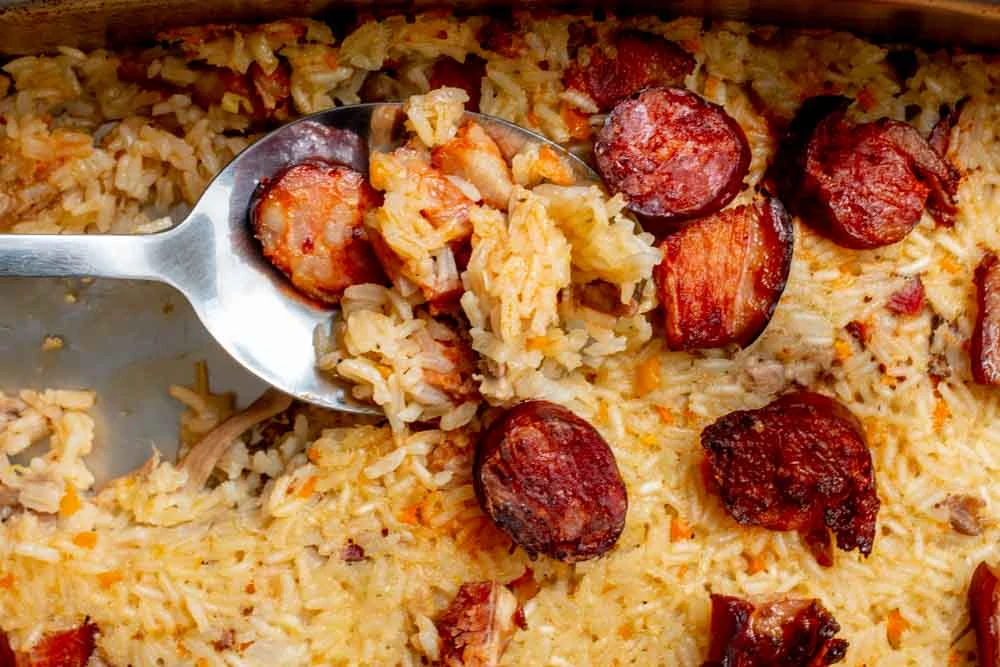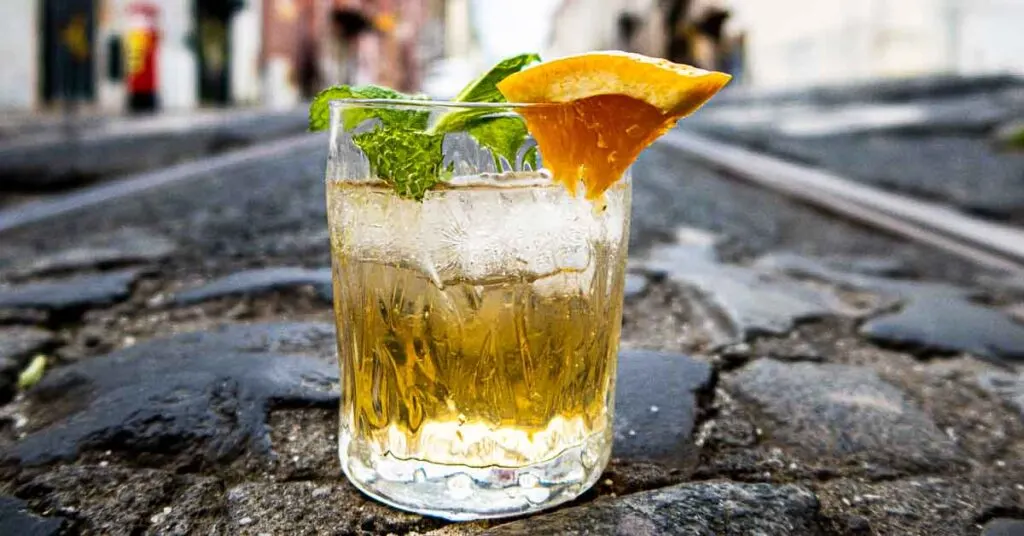Are you curious about cooking Portuguese food? If so, start with Bacalhau à Brás. Its classic recipe represents the best of Portuguese cuisine mixed into one delicious dish.

The mere mention of the word Portugal among travelers makes hearts glow and conjures visions of blue skies, sandy beaches and fairytale cobblestone streets. But, if you were to ask many of those same travelers about the food in Portugal, many would likely be clueless.
“There’s tapas, right?” is the response we’ve occasionally heard from the unindoctrinated. But, while small plates are sometimes served at Portuguese restaurants, that answer is incorrect.
So what is Portuguese food? We wrote about topic in a separate article that you can read later. You’re here to learn how to cook Portuguese food. So let’s begin with salt cod or bacalhau – the ubiquitous Portuguese ingredient found on menus throughout the country from Porto in the north to Lisbon in the center and all the way down to the Algarve in the south.

After living in Portugal for more than half a decade, it’s fair to say that we’ve eaten our share of salt cod. We were initially confounded by its bacalhau’s popularity considering the abundance of fresh seafood that’s readily available in Porguguese cities both big and small. But, as we learned the ins and outs of eating like locals, we grew to appreciate how preserved fish is ingrained in the country’s flavors.
Those flavors shine in Bacalhau à Brás, a dish where eggs provide a fatty binder for funky salt cod and a generous amount of carb-filled fried potatoes. It’s that simple. When you eat Bacalhau à Brás for lunch, you can almost imagine yourself sitting outside on a wooden dock with salt in the air and seagulls racing above.
With its bracingly briny salt cod, earthy caramelized potatoes, silky eggs and verdant herbs, Bacalhau à Brás may not sound initially enticing. Try it anyway. It’s Portugal’s answer to Italy’s carbonara, another dish where eggs bind together a group of independent ingredients. And, in case you’re wondering, both dishes pair well with dry white wine.
The History of Bacalhau à Brás

How did Bacalhau à Brás get its name and what are its roots? We have no definites here but the dish seems to have originated at an old-time restaurant and probably took on the name of that establishment. According to acclaimed Portuguese cookbook author Célia Pedroso, someone somewhere, most likely in Lisbon, probably served the dish at a restaurant called Braz (old Portuguese used a z) during the 19th century. But nobody seems to know exactly who did it first or where it happened.
Today, most Lisbon tascas (i.e. casual ‘working man’ taverns seemingly located on every block) proudly feature Bacalhau à Brás on their menus. We like to eat the dish on cold and rainy Lisbon afternoons. It makes for a wholesome and satisfying lunch that warms our bones while providing respite from from the city’s slippery sidewalks and hills. Yes, despite what you may have heard, it isn’t always sunny in Portugal.
Bacalhau à Brás Ingredients

At its essence, Bacalhau à Brás is a three ingredient dish. Those three ingredients are salt cod, potato and eggs. The recipe’s other ingredients, like bay leaves and cilantro, are supporting players that complete the dish.
That being said, salt cod is the dish’s star ingredient.
Why Salt Cod?

We didn’t frequently encounter salt cod when we lived in America except during holidays like Easter and Christmas. But salt cod, i.e. bacalhau, imported from Norway is everywhere in Portugal. You may be wondering why the Portuguese import so much salt cod since there’s so much fresh fish in Portugal. We wondered the same before we moved to Lisbon.
The answer lies in Portugal’s sea trade and bacalhau’s integral role in the nation’s maritime history. Preserved cod gained popularity back when sailors needed protein that they could preserve without refrigeration. Over the years, bacalhau left the shipyards and landed on Portuguese dinner tables both at restaurants and in homes. It’s a unique product – a salty, funky delicacy that tastes remarkably different from fresh fish and yet equally satisfying.
Ok. So now that we’ve dispensed of a bit of history, let’s talk about which salt cod to use and how to cook it.
Buying Salt Cod

Unlike markets in Portugal, American stores rarely (if ever) sell salt cod. However, thanks to the miracle of the internet, you can buy pre-cut bacalhau online.
We recommend buying loin or lombo as it’s called in Portuguese. It’s a more expensive cut but, once reconstituted, cod loin has a wonderful flake and silky texture. You can also buy salt cod ‘desfiado’ which is sold deboned and shredded. We prefer the loin despite the little bit of extra work required.
Soaking the Salt Cod

Soaking bacalhau is simple work. Ask any Lisbon native on the street and they’ll tell you the same thing: Deixar de molho durante trinta e seis horas e mudar a água de oito em oito horas. Translated: Soak for 36 hours and change the water every 8 hours.
We initially followed this rule and achieved good results though the fish was a bit salty. For our next attempt, we soaked the cod for an additional eight hours, with a new change of water, with ideal results.
Either way works but with caveats. If you go the 36-hour route, you’ll need to salt your Bacalhau à Brás judiciously when you cook it. Contrarily, if you soak the cod longer, you risk completely soaking the salt out of the fish. If that happens, you can compensate for salt as you follow the recipe. While this sounds like an ideal solution, you still may lose some of the fish’s natural salty flavor funk which is essential to this dish.
Prepping the Salt Cod

You need to remove the bones and thick skin after you soak the fish if you buy loin of salt cod. Don’t worry – the process is intuitve. Simply move the knife underneath the flesh and around the bones until the flesh is removed.
You don’t have to be overly precise since you’ll be chopping the fish later. Just make sure that the bones are removed and don’t cut yourself.
Beyond the Salt Cod

Unlike salt cod, the following ingredients should be easy to find in your pantry or at your local grocery store:
How to Make Bacalhau à Brás

The main thing to remember when you make Bacalhau à Brás at home is that you need to start soaking the salt cod at least 36 hours in advance. Once you do and you’re ready to make the dish, the first step is to slice the potatoes.
We slice our potatoes into matchsticks using a sharp chef’s knife. We prefer this method for this recipe, as opposed to using a mandoline or grater, for a couple reasons. First, we love the rusticity found in slightly uneven potatoes. Second, mandolines are dangerous. If, like us, you don’t use a mandoline frequently, it’s not worth the risk of injury.


Peel the potatoes before slicing them into matchsticks. Once peeled, cut the bottoms off so that the potatoes lie flat and then thinly slice the potatoes horizontally. Place the slices into small stacks and julienne them into matchsticks.
You can optionally soak the matchsticks to remove excess starch. This step may prevent the potatoes from sticking but it’s not necessary. If you do this extra step, be sure to dry the matchsticks before frying them.
Once the potatoes are sliced into matchsticks, whether you soak them or not, it’s time to fry them.
Frying the Potatoes


While housewives had to fry their potatoes back in the day, modern cooks have another option – using an air fryer. Both options work well in this recipe.
Option 1 – Air Frying Method
Trend followers can use an air fryer to fry their potatoes. We were initially sceptical about this method but then we tried it with our COSORI air fryer and it worked just fine. If you choose this method, you’ll want to do the following:
Prepare the potatoes by soaking them in water and dry them in a salad spinner or ring them out with a towel. Next, thoroughly mix the matchsticks with 2 tablespoons of olive oil and air fry them for about 15 to 20 minutes at 400°f / 200°c, stirring and turning them halfway through until they’re slightly brown on the edges. Remove the fryer drawer, give the potatoes a shake and set the potatoes aside either in the air fryer basket or on a paper towel lined plate.
Option 2 – Deep Frying Method
Traditional cooks will want to fry their potatoes the old fashioned way with a skillet. If you opt for this tried and true method, a 10-inch / 26cm cast iron skillet is the best vessel to use.
Heat the skillet on a high fire to 375°f / 190°c using a probe or candy thermometer to measure the heat. Once you reach the desired temperature, gently drop the sliced potatoes into the oil and cook for about 5 to 10 minutes until the edges of the matchsticks are just brown. Keep a diligent eye on the spuds – overbrown potatoes taste bitter. Once the potatoes are the right shade of brown, drain them on a paper towel or cooling rack and set them aside.
Pro Tip
Chop the salt cod into fine pieces while the poratoes are frying regardless of your chosen method.
Sautéing and Combining the Ingredients

Once you fry the potatoes, it’s time to sauté.
Start by sauteing the onions in a 12-inch stainless steel fry pan until they’re soft. Add a small amount of salt to the onions and then the garlic. Add the bacalhau and bay leaves. Mix thoroughly and cook until the cod and onions are heated through. After that, add the fried matchstick potatoes.
Cook until the potatoes are no longer stiff and the mixture is well incorporated – aout 3 to 5 minutes. Stir frequently

Next up – it’s time to add the eggs.
With this dish, there’s always the risk that the eggs will break and scramble but don’t panic. Instead, keep the heat on low and continue stirring the mixture for about a minute. You should be fine.
When the eggs are incorporated, remove the mixture from the heat and keep stirring. Plate the Bacalhau à Brás and top each serving with an olive of your choice – black, green or even red.
While we like to use kalamata olives, many Portuguese people prefer dark black olives straight from the can since that’s how they ate Bacalhau à Brás when they were young. Not having grown up in Portugal, we’re not limited by halcyon memories. Canned black olives don’t taste good to us.


You can even get fancy, as we like to do, by molding your Bacalhau à Brás with a round ring mold. If you do, make sure you fill the mold all the way before you slide it off otherwise your finished dish will look sloppy.
Bom apetite!!

Frequently Asked Questions
One of the most iconic Portuguese dishes, Bacalhau à Bras is a simple sauté of salt cod, potatoes and soft custard eggs.
Bacalhau à Brás was probably first cooked in Lisbon, Portugal during the 19th century; however, its exact history is a mystery.
Bacalhau à Brás’ main ingredients are salt cod, eggs and potatoes. Additional ingredients include onion, garlic, vegetable oil, olive oil, cilantro, bay leaves, salt, pepper and olives
Yes. Once the salt cod is soaked, which should be started at least 36 hours in advance, the dish can be made within an hour.
You’ll need to soak the cod for a minimum of 36 hours and a maximum of 50 hours in advance. Be careful not to soak it for too long. if you soak the fish for over 36 hours, you’ll lose a lot of its briny flavor. Also, don’t forget to change the water every eight hours.
Did you make this recipe? If so, please rate it below.
Bacalhau à Brás
Ingredients
- 1/2 pound salt cod loin (presoaked for 36-48 hours, with the water changed every eight hour; bones and skin removed after soaking; chopped fine)
- 1 pound potatoes (approximately 2 medium to large white or yukon gold; cut into matchstick strips)
- 3 eggs (whole large; beaten)
- 1 egg yolk (beaten with the whole eggs)
- 1 onion (medium; 1/4 inch slices)
- 2 cloves garlic (minced)
- 2 tablespoons olive oil (for the air fryer method)
- 3 tablespoons olive oil (for the saute)
- vegetable oil (for deep frying the potatoes – see pro tips section below)
- 2 bay leaves
- 1 tablespoon cilantro (chopped fine)
- salt (to taste)
- pepper (to taste)
- 4 olives (black or green)
Equipment
- Air Fryer (optional for the air fryer method)
- Candy Thermometer (optional for the air fryer method)
- Ring Mold (optional for plating)
Instructions
Air Frying the Potatoes – Option 1
- Mix the potato matchsticks with olive oil in a metal bowl.
- Place the mixture in the air fryer and cook at 400°f / 200°c for 15 to 20 minutes or until just browned on the edges. Stir once after 7 minutes.
- Once cooked, keep the air fried matchstick potatoes in the air fryer tray or dry them on a paper towel lined plate until you're ready to use them.
Deep Frying the Potatoes – Option 2
- Heat about 1 1/2 cups of oil in a 10 inch cast iron pan and heat to 375°f / 190°c
- Once the oil is heated, gently drop in in the matchstick potatoes. Fry the matchsticks for about 5 to 10 minutes in 2 to 3 batches until just browned on the edges. Drain the fried matchstick potatoes on a paper towel lined plate or a cooling rack until you're read to use them.
Cooking the Bacalhau à Bras – Both Options
- Heat olive oil in a 12-inch fry pan over medium heat.
- Cook the onions until softened and translucent. Add the garlic and sauté for one minute until fragrant. Add a small amount of salt to the onion/garlic sauté along with the bay leaves and stir.
- Add the salt cod to the fry pan and saute for about 5 minutes until the mixture is incorporated. Add the cilantro and stir.
- Turn the heat to low and pour in the egg mixture. Stir constantly until the eggs are incorporated. Remove the mixture from the heat and stir until it's slightly thick and custard like.
- Serve in an oval baking dish or mold individual servings with a ring mold. Garnish with the olives.
Pro Tips
- Use 1 1/2 cups of vegetable oil if you opt to deep fry the potaotes. After the potatoes are fried, you can pour the oil through a coffee filter and and re-use it.
- Double the portion size if you choose to serve the dish as a main course.
Estimated Nutrition
Hungry for More Portuguese Food?

About the Authors
Daryl and Mindi Hirsch
Saveur Magazine’s BEST TRAVEL BLOG award winners Daryl and Mindi Hirsch share their culinary travel experiences and recipes on the 2foodtrippers website. Since launching the site in 2012, they’ve traveled to over 40 countries in their quest to bring readers a unique taste of the world.
Original Publication Date: April 4, 2024





Celeste Rodrigues
Monday 8th of April 2024
First, the dish was named upon the last name of its creator; We, Portuguese use parsley not cilantro; The cod fish should be boiled for a few minutes. That will help to get rid of the extra salt and also will be easy to get rid of the skin and bones of the cod fish. Then the cod fish should be finely chipped, not chopped.
Daryl and Mindi Hirsch
Monday 8th of April 2024
Thanks for the input. We researched the recipe thoroughly and found some Portuguese use cilantro too. To us, 'coentros' is more traditionally Portuguese. Despite what 'tradition' may have told you, there's no need to boil the bacalhau and if you use 'lombo' chopping makes a more satisfying texture. Besides, the bacalhau will chip when you cook it anyway. Thanks for reading.